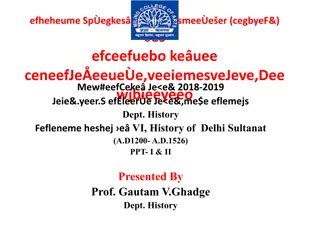
Dijkstra's Shortest Path Algorithm History and Impact
Explore the history and impact of Dijkstra's shortest path algorithm, its design in 1956, and the emergence of software engineering concepts from the 1968 NATO Conference. Learn about Edsger Dijkstra's quick invention of the algorithm and the evolution of programming methodology. Discover more about the development of high-level languages like Fortran and the significance of efficient code implementation.
Download Presentation

Please find below an Image/Link to download the presentation.
The content on the website is provided AS IS for your information and personal use only. It may not be sold, licensed, or shared on other websites without obtaining consent from the author. If you encounter any issues during the download, it is possible that the publisher has removed the file from their server.
You are allowed to download the files provided on this website for personal or commercial use, subject to the condition that they are used lawfully. All files are the property of their respective owners.
The content on the website is provided AS IS for your information and personal use only. It may not be sold, licensed, or shared on other websites without obtaining consent from the author.
E N D
Presentation Transcript
1 SHORTEST PATH ALGORITHM Lecture 19 CS2110 Spring 2018
A7. Implement shortest-path algorithm 2 Last semester: mean time: 3.7 hrs, median time: 4.0 hrs. We give you complete set of test cases and a GUI to play with. Efficiency and simplicity of code will be graded. Read pinned Assignment A7 note carefully: 2. Important! Grading guidelines. We demo it. A6 due Thursday FRIDAY. Late deadline still Sunday Working with a partner? Group before submitting!! We will talk about prelim 2 (24 April) on Thursday.
Dijkstras shortest-path algorithm 3 Edsger Dijkstra, in an interview in 2010 (CACM): the algorithm for the shortest path, which I designed in about 20 minutes. One morning I was shopping in Amsterdam with my young fiance, and tired, we sat down on the cafe terrace to drink a cup of coffee, and I was just thinking about whether I could do this, and I then designed the algorithm for the shortest path. As I said, it was a 20-minute invention. [Took place in 1956] Dijkstra, E.W. A note on two problems in Connexion with graphs. Numerische Mathematik 1, 269 271 (1959). Visit http://www.dijkstrascry.com for all sorts of information on Dijkstra and his contributions. As a historical record, this is a gold mine. 3
Dijkstras shortest-path algorithm 4 Dijsktra describes the algorithm in English: When he designed it in 1956 (he was 26 years old), most people were programming in assembly language. Only one high-level language: Fortran, developed by John Backus at IBM and not quite finished. No theory of order-of-execution time topic yet to be developed. In paper, Dijkstra says, my solution is preferred to another one the amount of work to be done seems considerably less. Dijkstra, E.W. A note on two problems in Connexion with graphs. Numerische Mathematik 1, 269 271 (1959). 4
1968 NATO Conference on Software Engineering 5 In Garmisch, Germany Academicians and industry people attended For first time, people admitted they did not know what they were doing when developing/testing software. Concepts, methodologies, tools were inadequate, missing The term software engineering was born at this conference. The NATO Software Engineering Conferences: http://homepages.cs.ncl.ac.uk/brian.randell/NATO/index.html Get a good sense of the times by reading these reports!
1968 NATO Conference on Software Engineering, Garmisch, Germany 6 Dijkstra Gries Term software engineering coined for this conference 6
1968 NATO Conference on Software Engineering, Garmisch, Germany 7 7
1968/69 NATO Conferences on Software Engineering Beards The reason why some people grow aggressive tufts of facial hair Is that they do not like to show the chin that isn't there. a grook by Piet Hein 8 Editors of the proceedings Edsger Dijkstra Niklaus Wirth Tony Hoare David Gries 8
Dijkstra s shortest path algorithm The n (> 0) nodes of a graph numbered 0..n-1. Each edge has a positive weight. wgt(v1, v2) is the weight of the edge from node v1 to v2. Some node v be selected as the start node. Calculate length of shortest path from v to each node. Use an array d[0..n-1]: for each node w, store in d[w] the length of the shortest path from v to w. d[0] = 2 d[1] = 5 d[2] = 6 d[3] = 7 d[4] = 0 0 2 4 2 v 3 3 1 4 4 3 1 9
The loop invariant Settled S Frontier F Far off (edges leaving the Far off set and edges from the Frontier to the Settled set are not shown) f 1. For a Settled node s, a shortest path from v to s contains only settled nodes and d[s] is length of shortest v s path. 2. For a Frontier node f, at least one v f path contains only settled nodes (except perhaps for f) and d[f] is the length of the shortest such path v f 3. All edges leaving S go to F. Another way of saying 3: There are no edges from S to the far-off set. Settled S This edge does not leave S! 10
Settled S Frontier F g Far off Theorem about the invariant v f L[g] L[f] f g 1. For a Settled node s, d[s] is length of shortest v s path. 2. For a Frontier node f, d[f] is length of shortest v f path using only Settled nodes (except for f). 3. All edges leaving S go to F. Theorem. For a node f in F with minimum d value (over nodes in F), d[f] is the length of a shortest path from v to f. Case 1: v is in S. Case 2: v is in F. Note that d[v] is 0; it has minimum d value 11
Settled S Frontier F Far off Theorem. For a node f in F with minimum d value (over nodes in F), d[f] is the length of a shortest path from v to f. f What does the theorem tell us about this frontier set? (Cortland, 20 miles) (Dryden, 11 miles) (Enfield, 10 miles) (Tburg, 15 miles) Answer: The shortest path from the start node to Enfield has length 10 miles. Note: the following answer is incorrect because we haven t said a word about the algorithm! We are just investigating properties of the invariant: Enfield can be moved to the settled set. 12
The algorithm S= { }; F= { v }; d[v]= 0; S F Far off v 1. For s, d[s] is length of shortest v s path. 2.For f, d[f] is length of shortest v f path using red nodes (except for f). 3.Edges leaving S go to F. Theorem: For a node f in F with min d value, d[f] is shortest path length Loopy question 1: How does the loop start? What is done to truthify the invariant? 13
The algorithm S= { }; F= { v }; d[v]= 0; S F Far off while ( ) { F {} 1. For s, d[s] is length of shortest v s path. 2.For f, d[f] is length of shortest v f path using red nodes (except for f). 3.Edges leaving S go to F. Theorem: For a node f in F with min d value, d[f] is shortest path length } Loopy question 2: When does loop stop? When is array d completely calculated? 14
The algorithm S= { }; F= { v }; d[v]= 0; S F Far off while ( ) { f= node in F with min d value; Remove f from F, add it to S; F {} f f 1. For s, d[s] is length of shortest v s path. 2.For f, d[f] is length of shortest v f path using red nodes (except for f). 3.Edges leaving S go to F. } Theorem: For a node f in F with min d value, d[f] is shortest path length Loopy question 3: Progress toward termination? 15
The algorithm S= { }; F= { v }; d[v]= 0; S F Far off w while ( ) { f= node in F with min d value; Remove f from F, add it to S; F {} w f for each neighbor w of f { 1. For s, d[s] is length of shortest v s path. if (w not in S or F) { 2.For f, d[f] is length of shortest v f path using red nodes (except for f). } else { 3.Edges leaving S go to F. } Theorem: For a node f in F with min d value, d[f] is shortest path length } } Loopy question 4: Maintain invariant? 16
The algorithm S= { }; F= { v }; d[v]= 0; while ( ) { f= node in F with min d value; Remove f from F, add it to S; S F Far off w F {} w f w for each neighbor w of f { d[w]= d[f] + wgt(f, w); add w to F; } else { 1. For s, d[s] is length of shortest v s path. 2.For f, d[f] is length of shortest v f path using red nodes (except for f). if (w not in S or F) { 3.Edges leaving S go to F. } Theorem: For a node f in F with min d value, d[f] is shortest path length } } Loopy question 4: Maintain invariant? 17
The algorithm S= { }; F= { v }; d[v]= 0; S F Far off w while ( ) { f= node in F with min d value; Remove f from F, add it to S; F {} f w for each neighbor w of f { d[w]= d[f] + wgt(f, w); add w to F; } else if (d[f] + wgt (f,w) < d[w]) { d[w]= d[f] + wgt(f, w); 1. For s, d[s] is length of shortest v s path. if (w not in S or F) { 2.For f, d[f] is length of shortest v f path of form f 3. Edges leaving S go to F. } Theorem: For a node f in F with min d value, d[f] is its shortest path length } } Algorithm is finished! 18
Extend algorithm to include the shortest path Let s extend the algorithm to calculate not only the length of the shortest path but the path itself. 1 3 0 4 d[0] = 2 d[1] = 5 d[2] = 6 d[3] = 7 d[4] = 0 3 2 2 1 4 v 3 4 19
Extend algorithm to include the shortest path Question: should we store in v itself the shortest path from v to every node? Or do we need another data structure to record these paths? v 0 0 0 Not finished! And how do we maintain it? 1 2 1 3 0 4 d[0] = 2 d[1] = 5 d[2] = 6 d[3] = 7 d[4] = 0 3 2 2 1 4 v 3 4 20
Extend algorithm to include the shortest path For each node, maintain the backpointer on the shortest path to that node. Shortest path to 0 is v -> 0. Node 0 backpointer is 4. Shortest path to 1 is v -> 0 -> 1. Node 1 backpointer is 0. Shortest path to 2 is v -> 0 -> 2. Node 2 backpointer is 0. Shortest path to 3 is v -> 0 -> 2 -> 1. Node 3 backpointer is 2. 1 3 bk[w] is w s backpointer 0 bk[0] = 4 bk[1] = 0 bk[2] = 0 bk[3] = 2 bk[4] (none) d[0] = 2 d[1] = 5 d[2] = 6 d[3] = 7 d[4] = 0 4 3 2 2 1 v 3 4 4 21
S F Far off Maintain backpointers S= { }; F= {v}; d[v]= 0; while (F {}) { f= node in F with min d value; Wow! It s so easy to maintain backpointers! Remove f from F, add it to S; for each neighbor w of f { if (w not in S or F) { d[w]= d[f] + wgt(f, w); add w to F; } else if (d[f] + wgt (f,w) < d[w]) { d[w]= d[f] + wgt(f, w); } }} When w not in S or F: Getting first shortest path so far: v f w bk[w]= f; When w in S or F and have shorter path to w: bk[w]= f; f v w 22
S F Far off This is our final high-level algorithm. These issues and questions remain: 1. How do we implement F? 2. The nodes of the graph will be objects of class Node, not ints. How will we maintain the data in arrays d and bk? 3. How do we tell quickly whether w is in S or F? 4. How do we analyze execution time of the algorithm? S= { }; F= {v}; d[v]= 0; while(F {}) { f= node in F with min d value; Remove f from F, add it to S; for each neighbor w of f { if (w not in S or F) { d[w]= d[f] + wgt(f, w); add w to F; bk[w]= f; } else if (d[f]+wgt (f,w) < d[w]) { d[w]= d[f] + wgt(f, w); bk[w]= f; } }} 23
S F Far off 1. How do we implement F? S= { }; F= {v}; d[v]= 0; while (F {}) { f= node in F with min d value; Use a min-heap, with the priorities being the distances! Remove f from F, add it to S; for each neighbor w of f { if (w not in S or F) { d[w]= d[f] + wgt(f, w); add w to F; bk[w]= f; } else if (d[f]+wgt (f,w) < d[w]) { d[w]= d[f] + wgt(f, w); bk[w]= f; } }} Distances ---priorities--- will change. That s why we need updatePriority in Heap.java 24
S F Far off For what nodes do we need a distance and a backpointer? S= { }; F= {v}; d[v]= 0; while(F {}) { f= node in F with min d value; Remove f from F, add it to S; for each neighbor w of f { if (w not in S or F) { d[w]= d[f] + wgt(f, w); add w to F; bk[w]= f; } else if (d[f]+wgt (f,w) < d[w]) { d[w]= d[f] + wgt(f, w); bk[w]= f; } }} 25
S F Far off For what nodes do we need a distance and a backpointer? S= { }; F= {v}; d[v]= 0; while(F {}) { f= node in F with min d value; For every node in S or F we need both its d-value and its backpointer (null for v) Remove f from F, add it to S; for each neighbor w of f { if (w not in S or F) { d[w]= d[f] + wgt(f, w); add w to F; bk[w]= f; } else if (d[f]+wgt (f,w) < d[w]) { d[w]= d[f] + wgt(f, w); bk[w]= f; } }} Instead of arrays d and b, keep information associated with a node. Use what data structure for the two values? 26
S F Far off For what nodes do we need a distance and a backpointer? S= { }; F= {v}; d[v]= 0; while(F {}) { f= node in F with min d value; For every node in S or F we need both its d-value and its backpointer (null for v) Remove f from F, add it to S; for each neighbor w of f { if (w not in S or F) { d[w]= d[f] + wgt(f, w); add w to F; bk[w]= f; } else if (d[f]+wgt (f,w) < d[w]) { d[w]= d[f] + wgt(f, w); bk[w]= f; } }} public class SF { private int distance; private node backPtr; } 27
S F Far off F implemented as a heap of Nodes. What data structure do we use to maintain an SF object for each node in S and F? S= { }; F= {v}; d[v]= 0; while(F {}) { f= node in F with min d value; Remove f from F, add it to S; for each neighbor w of f { if (w not in S or F) { d[w]= d[f] + wgt(f, w); add w to F; bk[w]= f; } else if (d[f]+wgt (f,w) < d[w]) { d[w]= d[f] + wgt(f, w); bk[w]= f; } }} For every node in S or F we need both its d-value and its backpointer (null for v): public class SF { private int distance; private node backPtr; } 28
S F Far off Given a node in S or F, we need to gets its SF object quickly. What data structure to use? S= { }; F= {v}; d[v]= 0; while(F {}) { f= node in F with min d value; HashMap<Node, SF> data Remove f from F, add it to S; for each neighbor w of f { if (w not in S or F) { d[w]= d[f] + wgt(f, w); add w to F; bk[w]= f; } else if (d[f]+wgt (f,w) < d[w]) { d[w]= d[f] + wgt(f, w); bk[w]= f; } }} Algorithm to implement Implement this algorithm. F: implemented as a min-heap. data: replaces S, d, b public class SF { private int distance; private node backPtr; } 29
S F Far off Investigate execution time. Important: understand algorithm well enough to easily determine the total number of times each part is executed/evaluated S= { }; F= {v}; d[v]= 0; while(F {}) { f= node in F with min d value; Remove f from F, add it to S; for each neighbor w of f { if (w not in S or F) { d[w]= d[f] + wgt(f, w); add w to F; bk[w]= f; } else if (d[f]+wgt (f,w) < d[w]) { d[w]= d[f] + wgt(f, w); bk[w]= f; } }} HashMap<Node, SFinfo> data Assume: n nodes reachable from v e edges leaving those n nodes public class SFinfo { private int distance; private node backPtr; } 30
S F Far off Assume: n nodes reachable from v e edges leaving the n nodes 1 x S= { }; F= {v}; d[v]= 0; while (F {}) { f= node in F with min d value; true n x n x n x Question. How many times does F {} evaluate to true? To false? Remove f from F, add it to S; for each neighbor w of f { if (w not in S or F) { d[w]= d[f] + wgt(f, w); add w to F; bk[w]= f; } else if (d[f]+wgt (f,w) < d[w]) { d[w]= d[f] + wgt(f, w); bk[w]= f; } }} HashMap<Node, SF> data public class SF { private int distance; private Node backptr; } 31
Directed graph n nodes reachable from v e edges leaving the n nodes S F Far off 1 x S= { }; F= {v}; d[v]= 0; while(F {}) { f= node in F with min d value; true n x n x n x Remove f from F, add it to S; for each neighbor w of f { if (w not in S or F) { d[w]= d[f] + wgt(f, w); add w to F; bk[w]= f; } else if (d[f]+wgt (f,w) < d[w]) { d[w]= d[f] + wgt(f, w); bk[w]= f; } }} HashMap<Node, SF> data Harder: In total, how many times does the loop for each neighbor w of f find a neighbor and execute the repetend? public class SF { private int distance; private Node backPtr; } 32
S F Far off Directed graph n nodes reachable from v e edges leaving the n nodes 1 x S= { }; F= {v}; d[v]= 0; while(F {}) { f= node in F with min d value; true n x n x n x Remove f from F, add it to S; for each neighbor w of f { if (w not in S or F) { d[w]= d[f] + wgt(f, w); add w to F; bk[w]= f; } else if (d[f]+wgt (f,w) < d[w]) { d[w]= d[f] + wgt(f, w); bk[w]= f; } }} Harder: In total, how many times does the loop for each neighbor w of f find a neighbor and execute the repetend? Answer: The for-each statement is executed ONCE for each node. During that execution, the repetend is executed once for each neighbor. In total then, the repetend is executed once for each neighbor of each node. A total of e times. 33
S F Far off Directed graph n nodes reachable from v e edges leaving the n nodes 1 x S= { }; F= {v}; d[v]= 0; while(F {}) { f= node in F with min d value; true n x n x n x Remove f from F, add it to S; for each neighbor w of f { if (w not in S or F) { d[w]= d[f] + wgt(f, w); add w to F; bk[w]= f; } else if (d[f]+wgt (f,w) < d[w]) { d[w]= d[f] + wgt(f, w); bk[w]= f; } }} true e x How many times does w not in S or F evaluate to true? e x n-1 x n-1 x Answer: If w is not in S or F, it is in the far-off set. When the main loop starts, n-1 nodes are in the far-off set. If w is in the far-off set, it is immediately put into w. Answer: n-1 times. 34
S F Far off Directed graph n nodes reachable from v e edges leaving the n nodes 1 x S= { }; F= {v}; d[v]= 0; while(F {}) { f= node in F with min d value; true n x n x n x Remove f from F, add it to S; for each neighbor w of f { if (w not in S or F) { d[w]= d[f] + wgt(f, w); add w to F; bk[w]= f; } else if (d[f]+wgt (f,w) < d[w]) { d[w]= d[f] + wgt(f, w); bk[w]= f; } }} true e x e x n-1 x n-1 x How many times is the if-statement executed? Answer: The repetend is executed e times. The if-condition in the repetend is true n-1 times. So the else-part is executed e-(n-1) times. Answer: e+1-n times. 35
S F Far off Directed graph n nodes reachable from v e edges leaving the n nodes 1 x S= { }; F= {v}; d[v]= 0; while(F {}) { f= node in F with min d value; true n x n x n x Remove f from F, add it to S; for each neighbor w of f { if (w not in S or F) { d[w]= d[f] + wgt(f, w); add w to F; bk[w]= f; } else if (d[f]+wgt (f,w) < d[w]) { d[w]= d[f] + wgt(f, w); bk[w]= f; } }} true e x e x n-1 x n-1 x e+1-n x How many times is the if- condition true and d[w] changed? Answer: We don t know. Varies. expected case: e+1-x times. 36
S F Far off Directed graph n nodes reachable from v e edges leaving the n nodes Expected-case analysis 1 x S= { }; F= {v}; d[v]= 0; while(F {}) { f= node in F with min d value; true n x n x n x Remove f from F, add it to S; for each neighbor w of f { if (w not in S or F) { d[w]= d[f] + wgt(f, w); add w to F; bk[w]= f; } else if (d[f]+wgt (f,w) < d[w]) { d[w]= d[f] + wgt(f, w); bk[w]= f; } }} We know how often each statement is executed. Multiply by its O( ) time true e x e x n-1 x n-1 x e+1-n x e+1-n x e+1-n x 37
S F Far off Directed graph n nodes reach- able from v e edges leaving the n nodes Expected-case analysis 1 x O(1) O(n) O(n) O(n log n) O(e) O(e) O(n) O(n log n) S= { }; F= {v}; d[v]= 0; while(F {}) { f= node in F with min d value; true n x n x n x Remove f from F, add it to S; for each neighbor w of f { if (w not in S or F) { d[w]= d[f] + wgt(f, w); add w to F; bk[w]= f; } else if (d[f]+wgt (f,w) < d[w]) { d[w]= d[f] + wgt(f, w); bk[w]= f; } }} true e x e x n-1 x n-1 x e+1-n x O(e n) e+1-n x e+1-n x O((e n) log n) O(e n) We know how often each statement is executed. Multiply by its O( ) time 38
S F Far off 1 x O(1) 1 O(n) 2 O(n) 3 O(n log n) 4 O(e) 5 O(e) 6 O(n) 7 O(n log n) 8 O(e n) 9 O((e n) log n). 10 O(e n) 10 S= { }; F= {v}; d[v]= 0; while(F {}) { f= node in F with min d value; true n x n x n x Remove f from F, add it to S; for each neighbor w of f { if (w not in S or F) { d[w]= d[f] + wgt(f, w); add w to F; bk[w]= f; } else if (d[f]+wgt (f,w) < d[w]) { d[w]= d[f] + wgt(f, w); bk[w]= f; } }} Sparse graph, so e close to n: Line 4 gives O(n log n) true e x e x n-1 x n-1 x e+1-n x e+1-n x e+1-n x Dense graph, so e close to n*n: Line 10 gives O(n2 log n) 39






















